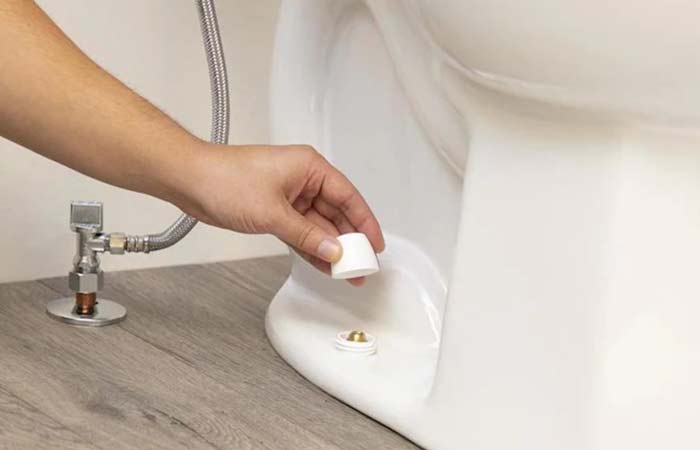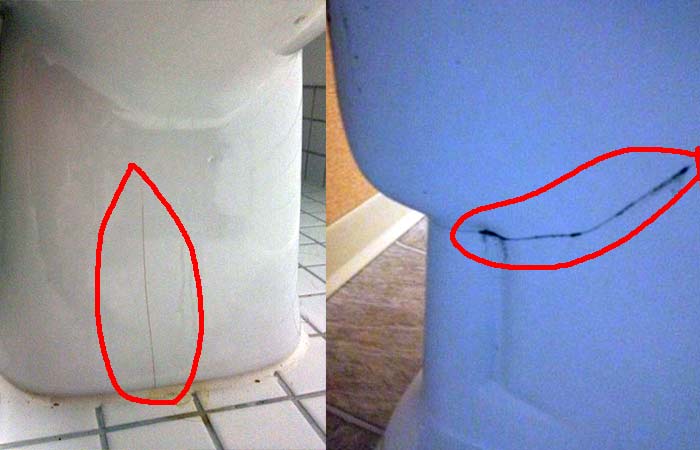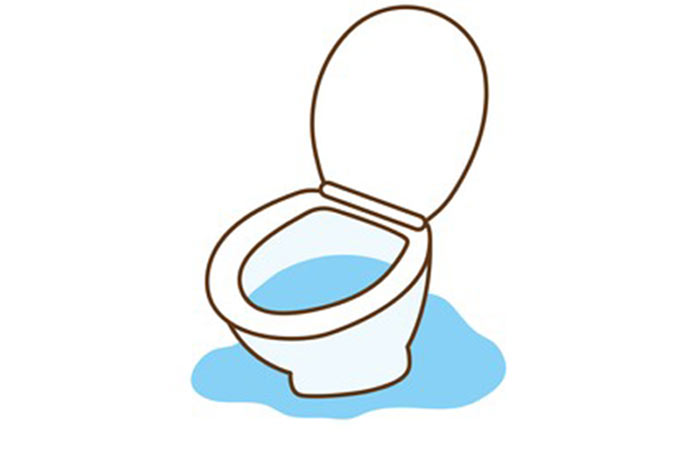Toilet Leaking at the Base, How to Tell, Causes & Fixes
A leaking toilet can be such a headache given the mess it creates and how much it can increase the water bill of the home or business. Worse still, the leaking water in most cases is dirty as it’s either from the P-trap or the area where the toilet meets the drain pipe. If not handled well, it can easily lead to contamination in the building.
Whether it’s when you flush it or not flushing, your toilet can leak from the base for various reasons including loose connection bolts, a faulty wax ring, a malfunctioning toilet tank, cracks on the toilet bowl, condensation on the toilet bowl etc.
The following are details on the causes of a leaky toilet base, how to check for and fix the leaks, plus tips to prevent the leaks. Some fixes can be done right at home while some will require the input of an expert.
Why is My Toilet Leaking at the Base when Flushed Only?
When your toilet leaks at the base, you might not even notice it especially when the color of the floor masks the wetness. Also, the water might be too little to make a pool on the floor that’s large enough to get your attention. Some of the causes for a leaking toilet base when flushed are as follows:
Loose Connection Bolts
The toilet’s connection bolts are what hold the seat of the toilet to the drainpipe and the floor. These bolts need to be very tight in that they don’t allow water or air to pass through the connection between the floor and the toilet seat.

The connection bolts need to have washers on them and should always be tight enough to keep the water stored in the P-trap of the toilet bowl from leaking out.
This connection is a delicate one that needs to have the wax ring and other gaskets and seals properly together. When the leak occurs accompanied by a foul smell, it’s usually a loose connection bolt or two.
Faulty Wax Ring
The wax ring of your toilet is one of the seals between the toilet seat and the drainpipe. As its name suggests, it’s made up of wax to both provide a watertight and airtight seal at the connection. The wax ring is a unique type of seal in that it’s a solid ring when new but disintegrates with time. This can lead to an easy breakdown and water and even sewer gases can escape through the wax ring unto the floor of the house.
A broken wax ring can be quite problematic given that it can bring about a leak inside the floor. This is especially bad for wooden floors since the floor can rot even without you knowing of it. The danger is that it can lead to a break down of a large part of the floor since the floor might not be strong enough to support the weight of the toilet and the user as well.
Cracks on the Toilet Bowl
When the toilet bowl is cracked, it can be hard seeing the actual crack since they often occur at the very base of the toilet bowl and can be very small. With cracks on the toilet bowl, water will leak to the floor depending on the location of the crack.
If the crack is located around the P-trap, the leak will occur even when you’re not using the toilet. On the other hand, if the crack is after the P-trap, leaks will occur only when you flush the toilet.
Leaks after the P-trap are tougher to identify due to less leaks but are more dangerous as they can easily compromise the whole toilet seat.

Causes when Not Flushed
If your toilet leaks even when not in use, the causes can be any of the following:
Cracks
As stated above, cracks on the toilet can lead to leaks with water pooling on the floor around the toilet. Cracks at the P-trap will lead to leaks on the floor when the toilet isn’t in use given that the P-trap has water at all times. This water can seep through the cracks and onto the floor.
Leaking toilet tank
The toilet tank holds water ready for flushing. This flushing is then controlled by a flapper mechanism. However, there are times the flapper doesn’t work well and let’s water flow to the bowl even when you’re not flushing the toilet.
If the toilet seat is in good condition, this leaking water will simply flow to the drainpipe. However, if the toilet bowl has cracks or the connection boots aren’t in good condition, you will observe water on the floor.
Another way a leaking toilet tank can lead to water being found on the floor of the toilet is when the seal around the pipe from the toilet tank isn’t in good condition. Water will then leak from the tank, trickle down the pipe and onto the floor around the toilet seat.
Condensation on the toilet bowl
If you live in a humid area or during the summer, water can condense on the outside of the toilet seat and if it’s a large enough amount, trickle to the floor and appear like a leak. If you observe this type of water on the floor in the evenings or when the air cools, it’s probably a problem with condensation.
How to Tell if Toilet is Leaking Underneath
You can check whether the toilet is leaking on the underside through a small test such as simply cleaning up the water on the floor then flushing the toilet again. If you see more water on the floor, it’s a leak from the toilet.
Another way to check for this type of leak is to mark the level of water in the inside of the bowl. If the water goes down without having used the toilet, it means there’s a leak on the toilet seat. In most cases, most toilets won’t experience leaks from the P-trap.

How to Fix a Leaky Toilet Around the Base
For the fixes below, you will need the following tools and supplies:
- Hand saw
- Rubber gloves
- Garbage bag
- A screwdriver set
- O-rings and washers
- Open end wrenches
- Cleaning cloth
- Putty knife
- Toilet wax ring
- Bathroom cleaner
- Toilet tank insulation
- Sponge
- Caulk
- Bucket
Fixing Loose Connection Bolts
When the bolts holding the toilet seat to the floor are loose or compromised such that you get a leak on the floor, follow the steps below to rectify the issue:
- Bend down and check the side of the toilet where it connects to the floor. Check to see if the T-bolts are loose or surrounded by water. It may be one or all of them with this issue.
- You can confirm the leak by drying the area around the bolts with a piece of cloth then wait for 15 to 30 minutes before checking again. If the bolts are wet, it means there is indeed a leak.
- You then turn off the water at the shutoff valve then flush the toilet.
- Remove the affected bolt with its washers then clean the area it comes from.
- Replace them with the new bolt with its washers.
You can test the integrity of the new bolts by turning the water on then checking whether there is a leak or not.
Fixing Faulty Wax Ring
When the issue is the wax ring, you can replace it as follows:
- Turn off the water into the toilet tank by turning the shutoff valve in a clockwise manner till it’s tight.
- Remove the lid from the toilet tank.
- Flush the toilet then hold down the handle to remove all the water from the toilet tank. You can remove any water in the toilet tank by using a sponge to mop it up from the tank.
- Disconnect the water supply line which is the line running from the shutoff valve to the toilet tank. Be sure not to remove the whole shutoff valve as you’ll have lots of water flowing to the floor of your toilet.
- Using a wrench, remove the bolts holding the toilet seat to the floor.
- While holding the toilet bowl with two hands, rock it back and forth gently until it comes off the floor. Pull it upwards and off the floor then place it on a soft surface like a towel or blanket.
- Using a putty knife, gently scrap the wax ring off the opening of the drainpipe to get a clean opening. Also clear out any debris or glue from the slots for the drain flange in readiness for the T bolts.
- Place into the drainpipe the new wax ring such that the plastic cone is facing the drain.
- Position the T bolts such that they are upright in readiness for the toilet seat.
- Pick up the toilet then place it on the drainpipe opening aligning the T bolts correctly. Do this gently to prevent any damage to the toilet.
- Return the bolts in place then tighten them with a wrench.
- Add caulk at the junction between the toilet seat and the floor.
- Reconnect the waterline and open the shutoff valve.
You can test whether it worked or not by checking whether the leak is persistent or not.
Dealing with Cracks on the Toilet
With cracks on the toilet, you should simply aim to replace it in totality before it leads to a disaster. The procedure for changing a toilet bowl are quite similar to those of changing the wax ring with the difference being you need to change the toilet bowl rather than returning the old one. You may still need to change the wax ring in the process.
Fixing a Faulty/Leaky Toilet Tank
When it’s the toilet tank leaking to the floor, you should start by sealing the area around the pipe from the toilet tank to the toilet bowl. You can do this with a silicon seal around the base of the toilet tank to keep the water in.
What to do when Toilet Leaking at Base all the Time
For this case, you might need to replace the whole toilet seat since it means that the other solutions don’t work and it’s a problem in the design of the toilet. This can also be due to a leak which can’t sealed or solved with simple procedures since the material used to make toilet seats is quite hard to rectify.
Tips to Prevent Base Leaks
Some of the tips you should put in place to prevent base leaks on the toilet include the following:
- Always check for the stability of the toilet seat. If you nudge it and it moves around, the nuts need to be tightened again.
- Use caulk every time you remove the toilet seat or other bathroom appliances.
- Always use the recommended seals, gaskets and rings for your type of toilet. When buying any of these, always carry the serial number of your toilet to know the type of toilet you have and what to get as a replacement.
- Routinely check the area around the toilet either on the floor or under it if the toilet is on an upper floor. This can help you identify leaks early and take care of it before it wreaks havoc.
With these tips, you can safely keep the toilet from leaking at the base.
Toilet Leaks: Further Reading